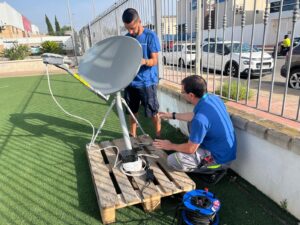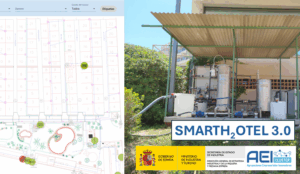Quantum teleportation allows the transfer of quantum information (qubits or quantum bits) from one place to another, making it potentially very important for secure communications, quantum computing, and the development of the next generation of the internet.
Experimental demonstrations of this effect, which involves the strange quantum entanglement (which ‘connects’ two distant particles in a quantum way), had previously only been done between adjacent nodes in a network. However, researchers at the Dutch institute QuTech have now achieved it between two nodes that are not directly connected.
“Our work demonstrates for the first time the teleportation of quantum information in a network, between nodes that are not directly connected,” says Ronald Hanson from QuTech.
The advancement, published in the journal Nature, represents a significant step towards the future quantum internet, according to the authors. They achieved this by establishing quantum links in a rudimentary network with three nodes: Alice, Bob, and Charlie, connected in line by optical fibers and a direct connection between the ‘neighbors’: Alice and Bob on one end, and Bob and Charlie on the other. However, in this system, Alice and Charlie are not neighbors.
“Neighbors in a quantum network means they have a direct fiber connection, and can create entanglement directly, that is, without the need for another node. In this case, whether or not they are neighbors has nothing to do with distance, but with connectivity, how the network is organized,” explains Hanson, emphasizing: “Our work demonstrates for the first time the teleportation of quantum information in a network, between nodes that are not directly connected.”
To be able to teleport the qubits, several ingredients are needed: an entangled quantum link between the sender and the receiver, a reliable method to read the quantum processors, and the capability to store these quantum bits temporarily.
Previous research at QuTech, a collaboration between Delft University of Technology and the Netherlands Organisation for Applied Scientific Research (TNO), had already demonstrated the possibility of transferring qubits between two neighboring nodes. The novelty now is achieving it for the first time between two non-neighboring nodes, that is, through a network, albeit a rudimentary one for now.
Specifically, they teleported quantum bits from Charlie to Alice, with the help of Bob, the intermediary node. The three operate using a kind of diamond impurity called the nitrogen-vacancy (NV) center.
Teleportation involves three steps. First, the ‘teleporter’ needs to be prepared, meaning an entangled state must be created between Alice and Charlie. They do not have a direct physical connection, but both are directly connected with Bob. Then Alice and Bob create an entangled state between their processors, Bob stores his part of the entangled state, and then he also entangles with Charlie.
Then a sort of quantum mechanics ‘sleight of hand’ takes place: through a special measurement in his processor, Bob ‘sends’ the entanglement, so that Alice and Charlie become entangled and the teleporter is ready to operate.
The second stage is to produce the ‘message,’ the qubit to be teleported. It can be, for example, a 1, a 0, or various intermediate values. Charlie prepares this quantum information. To demonstrate that teleportation works in a generic way, the researchers repeated the entire experiment for various values of quantum bits.
The third step is the actual teleportation from Charlie to Alice. To do this, Charlie makes a joint measurement with the message in his quantum processor and his half of the entangled state (Alice has the other half). What happens then is something only possible in the quantum world: as a result of this measurement, the information disappears on Charlie’s side and appears immediately on Alice’s side.
One might think that this completes the process, but nothing could be further from the truth. In fact, the qubit has been encrypted during transmission. The key is determined by Charlie’s measurement result, which he sends to Alice to perform the corresponding quantum operation and decrypt the quantum bit.
This could be done, for example, by flipping the bits: 0 becomes 1 and 1 becomes 0. After Alice has performed the correct operation, the quantum information is ready for further use. The teleportation has been successful.
The team’s future research will focus on reversing steps one and two of the protocol to optimize it and expand its possibilities. In any case, the authors believe that the exchange of information between unconnected nodes, as they have demonstrated, is a significant step towards building a quantum network that communicates through quantum teleportation.
However, complete teleportation in a quantum network is still a long way off, as explained in another article in Nature by researchers Oliver Slattery (from the NIST institute in the U.S.) and Yong-Su Kim (KIST, from South Korea). These authors explain that more improvements in several features of the system will be needed to enable multiple rounds of teleportation and to produce large-scale quantum networks.
Carlos Sabín, a researcher at the CSIC Institute of Fundamental Physics, also commented on this study for SMC Spain: “It could be seen as a very preliminary first step towards a quantum communication network. However, it is important to consider that the experimental difficulty makes the quality of information transmission still very low. This can be measured by calculating the so-called ‘fidelity’ of the transmitted state, that is, the similarity between the actual final state of the qubit and the state we intended to transmit.”
“Ideally, that fidelity should be 100%. If it is above 66.6%, we know that the process is impossible without using quantum physics. In the experiment, an average fidelity of 70% is achieved, but in some states it drops to 65%. This is enough to show that the process is quantum (at least on average), but obviously still far from any possible technological application, since the obtained state is 30% different from the original. There is still much work to be done to improve these percentages and to be able to extend the experiment to nodes further apart in the network.”
Miguel Ángel Martín-Delgado, professor of Theoretical Physics at the Complutense University of Madrid and coordinator of QUITEMAD (Quantum Information Technologies Madrid), adds: “Using spin qubits (quantum information units) inserted in diamonds and connected by optical fiber links, the team has succeeded in teleporting states, guaranteeing their quantum nature and with great efficiency. They have introduced many technical improvements that they hope will be reusable in other quantum platforms, but more information on the range of distances between the nodes is needed.”
“It is a necessary advance”, he concludes, “but still not enough to explore all the possibilities that open up when we manage to master quantum teleportation in a practical and routine way, and especially to teleport over sufficiently large distances.”
Referrer: MiMub in Spanish









